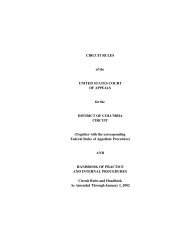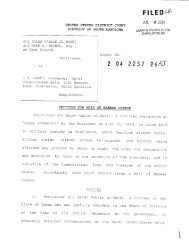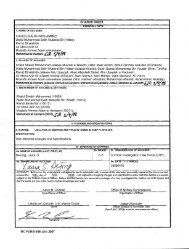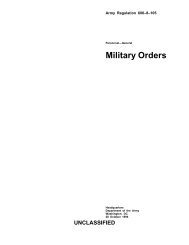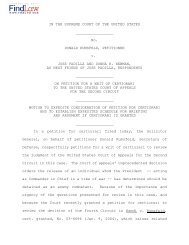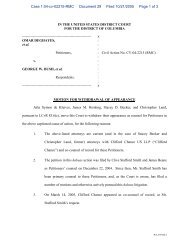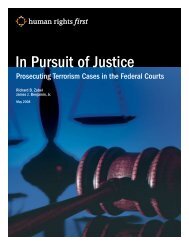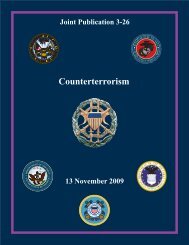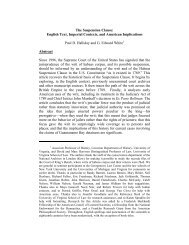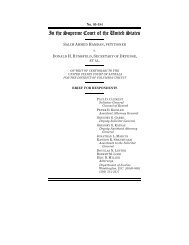JOHN PAUL STEVENS Joseph Thai âIt is confidence in the men and ...
JOHN PAUL STEVENS Joseph Thai âIt is confidence in the men and ...
JOHN PAUL STEVENS Joseph Thai âIt is confidence in the men and ...
Create successful ePaper yourself
Turn your PDF publications into a flip-book with our unique Google optimized e-Paper software.
<strong>JOHN</strong> <strong>PAUL</strong> <strong>STEVENS</strong><br />
<strong>Joseph</strong> <strong>Thai</strong> *<br />
“It <strong>is</strong> <strong>confidence</strong> <strong>in</strong> <strong>the</strong> <strong>men</strong> <strong>and</strong> wo<strong>men</strong> who adm<strong>in</strong><strong>is</strong>ter <strong>the</strong> judicial system,” John Paul<br />
Stevens once wrote, “that <strong>is</strong> <strong>the</strong> true backbone of <strong>the</strong> rule of law.” Bush v. Gore (2000)<br />
(d<strong>is</strong>sent<strong>in</strong>g). As a justice on <strong>the</strong> Supreme Court, Stevens has sought to adm<strong>in</strong><strong>is</strong>ter h<strong>is</strong><br />
part of <strong>the</strong> judicial system by exam<strong>in</strong><strong>in</strong>g <strong>the</strong> details of every case before him with great<br />
care, decid<strong>in</strong>g each based on <strong>the</strong> best judg<strong>men</strong>t he could apply to compet<strong>in</strong>g sides, <strong>and</strong><br />
expla<strong>in</strong><strong>in</strong>g <strong>the</strong> reasons for h<strong>is</strong> judg<strong>men</strong>ts as fully as possible. As a result of th<strong>is</strong> case-bycase<br />
approach, what has emerged from more than thirty years of Stevens’s work on <strong>the</strong><br />
Court <strong>is</strong> a volum<strong>in</strong>ous body of judicial op<strong>in</strong>ions that defy simple categorization by<br />
ideology or outcome, but that reveal a highly <strong>in</strong>telligent, <strong>in</strong>dependent, <strong>and</strong> honest effort to<br />
uphold <strong>the</strong> rule of law <strong>in</strong> cases large <strong>and</strong> small.<br />
Life<br />
Stevens’s roots were firmly planted <strong>in</strong> <strong>the</strong> Midwestern city of Chicago, where he was<br />
born on April 20, 1920. H<strong>is</strong> mo<strong>the</strong>r taught Engl<strong>is</strong>h <strong>in</strong> high school, <strong>and</strong> h<strong>is</strong> fa<strong>the</strong>r built<br />
<strong>and</strong> owned <strong>the</strong> lav<strong>is</strong>h Stevens Hotel, which went bust dur<strong>in</strong>g <strong>the</strong> Great Depression.<br />
Stevens received h<strong>is</strong> primary <strong>and</strong> secondary education at <strong>the</strong> University of Chicago<br />
Laboratory Schools, founded by <strong>the</strong> pragmat<strong>is</strong>t John Dewey. He also attended college at<br />
<strong>the</strong> University of Chicago, where he studied Engl<strong>is</strong>h literature. Upon graduat<strong>in</strong>g Phi Beta<br />
Kappa <strong>in</strong> 1941, Stevens enrolled <strong>in</strong> graduate studies <strong>the</strong>re with a view toward teach<strong>in</strong>g<br />
high-school Engl<strong>is</strong>h like h<strong>is</strong> mo<strong>the</strong>r.<br />
Over <strong>the</strong> summer of 1941, however, at <strong>the</strong> urg<strong>in</strong>g of a college dean who recruited for <strong>the</strong><br />
Navy, Stevens completed a naval correspondence course on cryptography, <strong>and</strong> on<br />
December 6, 1941, Stevens enl<strong>is</strong>ted <strong>in</strong> <strong>the</strong> Navy as a comm<strong>is</strong>sioned <strong>in</strong>telligence officer.<br />
The country’s apparent desperation <strong>in</strong> accept<strong>in</strong>g h<strong>is</strong> enl<strong>is</strong>t<strong>men</strong>t, Stevens once remarked,<br />
encouraged <strong>the</strong> next day’s attack on Pearl Harbor.<br />
From 1941-1945, Stevens served at Pearl Harbor as a code-breaker of <strong>in</strong>tercepted<br />
Japanese transm<strong>is</strong>sions. For th<strong>is</strong> critical work, at which he excelled, Stevens received a<br />
Bronze Star.<br />
Follow<strong>in</strong>g h<strong>is</strong> World War II service, Stevens heeded a bro<strong>the</strong>r’s advice to serve <strong>the</strong><br />
public as an attorney, <strong>and</strong> enrolled <strong>in</strong> law school at Northwestern University. There, he<br />
became <strong>the</strong> editor-<strong>in</strong>-chief of <strong>the</strong> law review <strong>and</strong> graduated first <strong>in</strong> h<strong>is</strong> class after two<br />
years, with <strong>the</strong> highest grade po<strong>in</strong>t average <strong>in</strong> <strong>the</strong> school’s h<strong>is</strong>tory. On <strong>the</strong> strength of h<strong>is</strong><br />
academic record, as well as <strong>the</strong> recom<strong>men</strong>dation of professors who considered him “<strong>the</strong><br />
* Associate Professor of Law, University of Oklahoma. A.B., 1995, Harvard College; J.D., 1998, Harvard<br />
Law School. Law Clerk, 2000-2001, Justice John Paul Stevens. Th<strong>is</strong> article will be publ<strong>is</strong>hed <strong>in</strong> The<br />
Encyclopedia of <strong>the</strong> Supreme Court of <strong>the</strong> United States (Macmillan 2008).
quickest” <strong>and</strong> “best balanced m<strong>in</strong>d” <strong>the</strong>y had encountered, Justice Wiley Rutledge hired<br />
Stevens as a law clerk for <strong>the</strong> Supreme Court’s 1947-1948 term. (Rosen p. 55).<br />
Rutledge left a profound impression on <strong>the</strong> young Stevens. After <strong>the</strong> clerkship, Stevens<br />
recalled with admiration h<strong>is</strong> <strong>men</strong>tor’s “pa<strong>in</strong>stak<strong>in</strong>g review” of every aspect of a case, h<strong>is</strong><br />
deliberate “habit of underst<strong>and</strong><strong>in</strong>g before d<strong>is</strong>agree<strong>in</strong>g,” h<strong>is</strong> preference for reasoned<br />
judg<strong>men</strong>t <strong>and</strong> practical considerations over “<strong>the</strong>oretical rules,” <strong>and</strong> h<strong>is</strong> “conviction that an<br />
<strong>in</strong>dependent judiciary <strong>is</strong> absolutely necessary for <strong>the</strong> preservation of law.” (Stevens<br />
1956, pp. 179-198). Later, as a justice, Stevens would follow Rutledge’s methodological<br />
example, <strong>and</strong> <strong>in</strong> <strong>the</strong> context of a different world struggle, Stevens would reaffirm<br />
Rutledge’s core belief <strong>in</strong> <strong>the</strong> <strong>in</strong>d<strong>is</strong>pensability of due process <strong>in</strong> wartime.<br />
After <strong>the</strong> clerkship, Steven returned to Chicago <strong>and</strong> entered private practice. He proved<br />
very successful as an antitrust lawyer, served on prom<strong>in</strong>ent congressional <strong>and</strong> executive<br />
committees study<strong>in</strong>g antitrust matters, taught <strong>the</strong> subject at Northwestern <strong>and</strong> <strong>the</strong><br />
University of Chicago, <strong>and</strong> publ<strong>is</strong>hed <strong>in</strong> <strong>the</strong> field.<br />
The respect Stevens earned as a lawyer led to h<strong>is</strong> appo<strong>in</strong>t<strong>men</strong>t <strong>in</strong> 1969 to <strong>in</strong>vestigate<br />
allegations that two justices on <strong>the</strong> Ill<strong>in</strong>o<strong>is</strong> Supreme Court had accepted bribes. Stevens’s<br />
widely-pra<strong>is</strong>ed <strong>in</strong>vestigation, which led to <strong>the</strong> resignation of those justices, garnered <strong>the</strong><br />
attention of Senator Charles Percy of Ill<strong>in</strong>o<strong>is</strong>, who recom<strong>men</strong>ded him for appo<strong>in</strong>t<strong>men</strong>t to<br />
<strong>the</strong> Seventh Circuit Court of Appeals. President Richard Nixon did so <strong>in</strong> 1970.<br />
As a Seventh Circuit judge, Stevens wrote op<strong>in</strong>ions of “cons<strong>is</strong>tent excellence” <strong>in</strong> “an<br />
aston<strong>is</strong>h<strong>in</strong>g number of areas,” accord<strong>in</strong>g to an ABA representative evaluat<strong>in</strong>g h<strong>is</strong><br />
subsequent Supreme Court nom<strong>in</strong>ation. (<strong>Thai</strong> 2006, p. 1556). President Gerald Ford<br />
nom<strong>in</strong>ated Stevens upon Justice William Douglas’s retire<strong>men</strong>t, with <strong>the</strong> hope of unit<strong>in</strong>g<br />
<strong>the</strong> country after Watergate beh<strong>in</strong>d a non-ideological nom<strong>in</strong>ee of unquestionable merit.<br />
Less than a month later, <strong>the</strong> Senate approved by a vote of 98-0.<br />
Judicial Method<br />
Accord<strong>in</strong>g to Justice Lou<strong>is</strong> Br<strong>and</strong>e<strong>is</strong>, one reason <strong>the</strong> public respects <strong>the</strong> members of <strong>the</strong><br />
Supreme Court <strong>is</strong> that “<strong>the</strong>y are almost <strong>the</strong> only people <strong>in</strong> Wash<strong>in</strong>gton who do <strong>the</strong>ir own<br />
work.” (Wyzanski p. 61). John Paul Stevens has adhered to th<strong>is</strong> venerable practice as a<br />
justice. In an era of <strong>in</strong>creas<strong>in</strong>g reliance on law clerks, Stevens alone has <strong>in</strong>s<strong>is</strong>ted on h<strong>is</strong><br />
chambers <strong>in</strong>dependently review<strong>in</strong>g <strong>the</strong> thous<strong>and</strong>s of certiorari petitions filed each year,<br />
ra<strong>the</strong>r than rely<strong>in</strong>g on a pool of law clerks from <strong>the</strong> eight o<strong>the</strong>r chambers for a<br />
recom<strong>men</strong>dation on whe<strong>the</strong>r <strong>the</strong> Court should hear a case. Stevens also st<strong>and</strong>s out as <strong>the</strong><br />
only justice on <strong>the</strong> current Court to write <strong>the</strong> first drafts of h<strong>is</strong> op<strong>in</strong>ions, ra<strong>the</strong>r than rev<strong>is</strong>e<br />
those crafted by law clerks. In h<strong>is</strong> words, writ<strong>in</strong>g <strong>the</strong> <strong>in</strong>itial draft <strong>is</strong> “terribly important,”<br />
because it gives him “a chance to th<strong>in</strong>k it through,” <strong>and</strong> “you don’t often underst<strong>and</strong> a<br />
case until you’ve tried to write it out.” (Rosen p. 72).<br />
Stevens’s op<strong>in</strong>ions bear a remarkable resemblance <strong>in</strong> form to those of h<strong>is</strong> admired<br />
<strong>men</strong>tor. As he has described Rutledge’s op<strong>in</strong>ions, h<strong>is</strong> own typically conta<strong>in</strong> a “full<br />
2
state<strong>men</strong>t of all <strong>the</strong> factors which lead to <strong>and</strong> qualify <strong>the</strong> result which <strong>is</strong> eventually<br />
reached,” as well as a “full state<strong>men</strong>t of oppos<strong>in</strong>g argu<strong>men</strong>ts <strong>and</strong> countervail<strong>in</strong>g<br />
considerations” found less persuasive, <strong>in</strong>dicat<strong>in</strong>g that “<strong>the</strong> faculty of judg<strong>men</strong>t <strong>and</strong> not<br />
merely <strong>the</strong> logical application of unbend<strong>in</strong>g pr<strong>in</strong>ciples has been employed to resolve an<br />
actual controversy between litigants.” (Stevens 1956, p. 182).<br />
Although Stevens has wryly noted a preference for writ<strong>in</strong>g majority op<strong>in</strong>ions, he has<br />
d<strong>is</strong>t<strong>in</strong>gu<strong>is</strong>hed himself for writ<strong>in</strong>g more d<strong>is</strong>sents than any of h<strong>is</strong> colleagues on <strong>the</strong> Court.<br />
Dubbed “<strong>the</strong> d<strong>is</strong>senter” by <strong>the</strong> New York Times, Stevens has eschewed mask<strong>in</strong>g<br />
d<strong>is</strong>agree<strong>men</strong>t for <strong>the</strong> appearance of unity on <strong>the</strong> Court. As he has expla<strong>in</strong>ed, “I just feel I<br />
have an obligation to expose my views to <strong>the</strong> public.” (Rosen p. 56).<br />
Whe<strong>the</strong>r writ<strong>in</strong>g for <strong>the</strong> Court or himself, Stevens has strongly preferred decid<strong>in</strong>g each<br />
case narrowly based on reasons particular to its context, ra<strong>the</strong>r than, as colleagues such as<br />
Anton<strong>in</strong> Scalia has espoused, broadly based on categorical rules fashioned by judges.<br />
Stevens’s approach falls with<strong>in</strong> a common law tradition of judicial restra<strong>in</strong>t, whereby<br />
judges develop <strong>the</strong> law slowly <strong>and</strong> cautiously over <strong>the</strong> course of many cases. For<br />
Stevens, <strong>the</strong> approach reflects a “duty to avoid unnecessary lawmak<strong>in</strong>g,” as well as<br />
pragmatic m<strong>is</strong>trust of “untried state<strong>men</strong>ts of general pr<strong>in</strong>ciples.” (Stevens 1982, p. 180;<br />
Stevens 1956, p. 188). It also reflects h<strong>is</strong> central conviction that sound judicial dec<strong>is</strong>ions<br />
ultimately require use of <strong>the</strong> faculty of judg<strong>men</strong>t, which reliance on absolute pr<strong>in</strong>ciples<br />
obscures but does not avoid.<br />
Stevens’s sense of duty <strong>and</strong> pragmat<strong>is</strong>m has led him, when constru<strong>in</strong>g statutes, to attempt<br />
to effectuate <strong>the</strong> will of <strong>the</strong> leg<strong>is</strong>lature through consideration of “all reliable evidence of<br />
leg<strong>is</strong>lative <strong>in</strong>tent.” Exxon Mobil Corp. v. Allaptattah Services (2005) (d<strong>is</strong>sent<strong>in</strong>g).<br />
Because “any question of statutory construction requires <strong>the</strong> judge to decide how <strong>the</strong><br />
leg<strong>is</strong>lature <strong>in</strong>tended its enact<strong>men</strong>t to apply to <strong>the</strong> case at h<strong>and</strong>,” Stevens believes <strong>in</strong><br />
review<strong>in</strong>g not only <strong>the</strong> relevant statutory prov<strong>is</strong>ion but <strong>the</strong> entire statute, <strong>and</strong> consider<strong>in</strong>g<br />
<strong>the</strong> statute <strong>in</strong> light of leg<strong>is</strong>lative h<strong>is</strong>tory as well as h<strong>is</strong>torical context. Griff<strong>in</strong> v. Oceanic<br />
Contractors (1982) (d<strong>is</strong>sent<strong>in</strong>g). As he has written, rely<strong>in</strong>g solely on <strong>the</strong> text of <strong>the</strong><br />
statute may leave a court “un<strong>in</strong>formed, <strong>and</strong> hence unconstra<strong>in</strong>ed” to <strong>in</strong>terpret an<br />
ambiguous prov<strong>is</strong>ion cons<strong>is</strong>tent with its own policy preference, ra<strong>the</strong>r than with <strong>the</strong><br />
leg<strong>is</strong>lative purpose beh<strong>in</strong>d <strong>the</strong> enact<strong>men</strong>t. Circuit City v. Adams (2001) (d<strong>is</strong>sent<strong>in</strong>g).<br />
When constru<strong>in</strong>g <strong>the</strong> Constitution, Stevens has sought to imple<strong>men</strong>t its funda<strong>men</strong>tal<br />
pr<strong>in</strong>ciples one case at a time. He has specifically rejected <strong>the</strong> more ambitious approach<br />
of colleagues like Justices Scalia <strong>and</strong> Clarence Thomas of d<strong>is</strong>cover<strong>in</strong>g <strong>and</strong> follow<strong>in</strong>g <strong>the</strong><br />
orig<strong>in</strong>al mean<strong>in</strong>g of <strong>the</strong> constitutional text. While he believes that orig<strong>in</strong>al underst<strong>and</strong><strong>in</strong>g<br />
may be important, he does not th<strong>in</strong>k it <strong>is</strong> always possible, as a practical matter, to div<strong>in</strong>e<br />
how words written centuries ago were meant to apply <strong>in</strong> unforeseen contexts.<br />
More importantly, <strong>in</strong> Stevens’s view, <strong>the</strong> Framers of <strong>the</strong> Constitution “made no attempt<br />
to fashion a Napoleonic Code that would provide detailed answers to <strong>the</strong> many questions<br />
that would <strong>in</strong>evitably confront future generations.” Instead, <strong>the</strong>y often used general<br />
language with <strong>the</strong> expectation that “<strong>the</strong> vast open spaces <strong>in</strong> our charter of govern<strong>men</strong>t”<br />
3
would be <strong>in</strong>terpreted <strong>in</strong>cre<strong>men</strong>tally “by <strong>the</strong> common-law process of step-by-step<br />
adjudication that was largely responsible for <strong>the</strong> develop<strong>men</strong>t of <strong>the</strong> law at <strong>the</strong> time th<strong>is</strong><br />
nation was conceived.” (Stevens 1992, p. 35-36). The process of faithfully apply<strong>in</strong>g<br />
basic <strong>and</strong> broad constitutional pr<strong>in</strong>ciples—such as “liberty,” “due process,” <strong>and</strong> “equal<br />
protection”—relies on <strong>the</strong> exerc<strong>is</strong>e of impartial judg<strong>men</strong>t for which <strong>the</strong> Constitution<br />
granted judges life tenure, accord<strong>in</strong>g to Stevens. And “just as <strong>the</strong> Framers <strong>the</strong>mselves<br />
decided to say no more than was necessary,” Stevens <strong>in</strong>fers that “<strong>the</strong>ir silence was a<br />
comm<strong>and</strong> to <strong>the</strong> judges of <strong>the</strong> future to exerc<strong>is</strong>e comparable self-restra<strong>in</strong>t.” (Stevens<br />
1985, p. 452).<br />
Cases<br />
Stevens’s views on judicial restra<strong>in</strong>t have led him, <strong>in</strong> <strong>the</strong> leg<strong>is</strong>lative context, to defer to<br />
<strong>the</strong> reasonable <strong>in</strong>terpretations of adm<strong>in</strong><strong>is</strong>trative agencies constru<strong>in</strong>g statutory ambiguity<br />
or silence <strong>in</strong> one of h<strong>is</strong> most important op<strong>in</strong>ions for <strong>the</strong> Court, Chevron v. Natural<br />
Resources Defense Council (1984). Out of respect for congressional delegation of<br />
policymak<strong>in</strong>g authority, <strong>and</strong> out of pragmatic recognition of adm<strong>in</strong><strong>is</strong>trative expert<strong>is</strong>e,<br />
Chevron gave breath<strong>in</strong>g room to <strong>the</strong> modern adm<strong>in</strong><strong>is</strong>trative state by allow<strong>in</strong>g agencies to<br />
fill <strong>in</strong> statutory gaps not on <strong>the</strong> bas<strong>is</strong> of “judges’ personal policy preferences,” but “<strong>in</strong><br />
light of every day realities,” <strong>and</strong> cons<strong>is</strong>tent with <strong>the</strong> policies of a democratically<br />
accountable <strong>in</strong>cumbent adm<strong>in</strong><strong>is</strong>tration.<br />
Chevron does not, however, permit an agency to d<strong>is</strong>regard an unambiguous congressional<br />
comm<strong>and</strong>, as Stevens made clear <strong>in</strong> <strong>the</strong> l<strong>and</strong>mark environ<strong>men</strong>tal case of Massachusetts v.<br />
EPA (2007). Through h<strong>is</strong> majority op<strong>in</strong>ion, <strong>the</strong> Court held that <strong>the</strong> President’s antiregulatory<br />
stance on global warm<strong>in</strong>g could not d<strong>is</strong>place Congress’ clear directive <strong>in</strong> <strong>the</strong><br />
Clean Air Act that <strong>the</strong> Environ<strong>men</strong>tal Protection Agency “shall” regulate greenhouse<br />
gases from em<strong>is</strong>sions of new motor vehicles upon an agency f<strong>in</strong>d<strong>in</strong>g of public<br />
endanger<strong>men</strong>t.<br />
The constitutional balance of power between Congress <strong>and</strong> <strong>the</strong> President also came to <strong>the</strong><br />
fore <strong>in</strong> Hamdan v. Rumsfeld (2006). In perhaps <strong>the</strong> most significant presidential powers<br />
dec<strong>is</strong>ion <strong>in</strong> a generation, Stevens reaffirmed for <strong>the</strong> Court <strong>the</strong> funda<strong>men</strong>tal constitutional<br />
pr<strong>in</strong>ciple that “<strong>the</strong> Executive <strong>is</strong> bound to comply with <strong>the</strong> Rule of Law that prevails <strong>in</strong><br />
th<strong>is</strong> jur<strong>is</strong>diction.” As a result, <strong>the</strong> Court <strong>in</strong>validated <strong>the</strong> military comm<strong>is</strong>sions created<br />
unilaterally by President George W. Bush to try terror suspects at <strong>the</strong> Guantanamo Bay<br />
Naval Base, Cuba. Those tribunals violated federal law, accord<strong>in</strong>g to Hamdan, by fail<strong>in</strong>g<br />
to provide <strong>the</strong> most basic protections afforded by military laws <strong>and</strong> treaties, <strong>in</strong>clud<strong>in</strong>g <strong>the</strong><br />
right of an accused to see <strong>and</strong> hear evidence aga<strong>in</strong>st him.<br />
Hamdan itself was made possible by ano<strong>the</strong>r key terror<strong>is</strong>m dec<strong>is</strong>ion which Stevens<br />
authored, Rasul v. Bush (2004). There, <strong>the</strong> Court rejected <strong>the</strong> President’s position that<br />
Guantanamo Bay’s location outside <strong>the</strong> United States deprived federal courts of<br />
jur<strong>is</strong>diction, through <strong>the</strong> writ of habeas corpus, to review <strong>the</strong> legality of <strong>the</strong> detention of<br />
foreigners held <strong>the</strong>re. In do<strong>in</strong>g so, Stevens’s op<strong>in</strong>ion revived <strong>the</strong> d<strong>is</strong>sent<strong>in</strong>g view of<br />
Justice Rutledge <strong>in</strong> Ahrens v. Clark (1948)—a case Stevens worked on as a law clerk—<br />
4
that such a “narrow <strong>and</strong> rigid territorial limitation” should be “avoid generally, even<br />
assiduously, out of regard for <strong>the</strong> writ’s great office <strong>in</strong> <strong>the</strong> v<strong>in</strong>dication of personal<br />
liberty.”<br />
Indeed, Hamdan <strong>and</strong> Rasul reflect Rutledgean vigilance for preserv<strong>in</strong>g <strong>the</strong> rule of law<br />
<strong>and</strong> <strong>the</strong> freedom that it guarantees through protect<strong>in</strong>g access to an <strong>in</strong>dependent judiciary<br />
<strong>and</strong> ensur<strong>in</strong>g fair process even <strong>in</strong> wartime. But as significant as <strong>the</strong>se dec<strong>is</strong>ions were,<br />
<strong>the</strong>y were not sweep<strong>in</strong>g. Hamdan, for its part, <strong>in</strong>validated only <strong>the</strong> specific tribunals<br />
establ<strong>is</strong>hed by <strong>the</strong> President <strong>and</strong> challenged by <strong>the</strong> deta<strong>in</strong>ee <strong>in</strong> that case, <strong>and</strong> left <strong>the</strong> door<br />
open for comm<strong>is</strong>sions constituted <strong>in</strong> accordance with federal law. Rasul, likew<strong>is</strong>e,<br />
limited its hold<strong>in</strong>g to its particular context, f<strong>in</strong>d<strong>in</strong>g <strong>the</strong> United States’s sovereign control<br />
over Guantanamo Bay sufficed to support habeas jur<strong>is</strong>diction, but decl<strong>in</strong><strong>in</strong>g to op<strong>in</strong>e<br />
whe<strong>the</strong>r jur<strong>is</strong>diction might extend anywhere or everywhere else.<br />
Th<strong>is</strong> practice of decid<strong>in</strong>g no more than necessary d<strong>is</strong>plays, <strong>in</strong> <strong>the</strong>se cases, not only<br />
Stevens’s judicial restra<strong>in</strong>t <strong>and</strong> pragmat<strong>is</strong>m. By leav<strong>in</strong>g room for <strong>the</strong> political branches to<br />
respond <strong>in</strong> matters of national security, <strong>the</strong>se dec<strong>is</strong>ions also exhibit Stevens’s respect for<br />
<strong>the</strong>ir coord<strong>in</strong>ate role <strong>in</strong> our constitutional system. As he has stated elsewhere, <strong>the</strong> better<br />
course <strong>is</strong> to decide <strong>the</strong> case “actually presented” than “to craft an all-encompass<strong>in</strong>g rule<br />
for <strong>the</strong> future,” for it <strong>is</strong> “far w<strong>is</strong>er” to give elected officials “an unimpeded opportunity to<br />
grapple with <strong>the</strong>se emerg<strong>in</strong>g <strong>is</strong>sues . . . than to shackle <strong>the</strong>m with prematurely dev<strong>is</strong>ed<br />
constitutional constra<strong>in</strong>ts.” Kyllo v. United States (2001) (d<strong>is</strong>sent<strong>in</strong>g).<br />
Stevens’s preference for “small” dec<strong>is</strong>ions recurs <strong>in</strong> nearly all areas of law. (Schauer p.<br />
544). For example, <strong>in</strong> <strong>the</strong> free speech area, Stevens upheld for <strong>the</strong> Court <strong>the</strong><br />
govern<strong>men</strong>t’s power to proscribe <strong>the</strong> afternoon radio broadcast of George Carl<strong>in</strong>’s “seven<br />
dirty words” monologue, but took pa<strong>in</strong>s to emphasize <strong>the</strong> “host of variables” limit<strong>in</strong>g <strong>the</strong><br />
dec<strong>is</strong>ion, <strong>in</strong>clud<strong>in</strong>g <strong>the</strong> hour of <strong>the</strong> program <strong>and</strong> <strong>the</strong> pervasiveness of <strong>the</strong> broadcast<br />
medium. FCC v. Pacifica Foundation (1978). More famously, <strong>in</strong> Texas v. Johnson<br />
(1989) (d<strong>is</strong>sent<strong>in</strong>g), Stevens vigorously argued that <strong>the</strong> govern<strong>men</strong>t may ban <strong>the</strong> burn<strong>in</strong>g<br />
of <strong>the</strong> American flag, because, unlike o<strong>the</strong>r emblems, it “uniquely symbolizes” <strong>the</strong><br />
nation’s ideals of “liberty <strong>and</strong> equality,” <strong>and</strong> <strong>is</strong> “worthy of protection from unnecessary<br />
desecration.”<br />
In <strong>the</strong>se <strong>and</strong> o<strong>the</strong>r First A<strong>men</strong>d<strong>men</strong>t cases, Stevens has eschewed <strong>the</strong> Court’s absolut<strong>is</strong>t<br />
framework of divid<strong>in</strong>g speech <strong>in</strong> <strong>the</strong> abstract <strong>in</strong>to “protected” <strong>and</strong> “unprotected” classes,<br />
<strong>and</strong> presumptively <strong>in</strong>validat<strong>in</strong>g regulations that target protected speech because of its<br />
content. On <strong>the</strong> view that such an “all-or-noth<strong>in</strong>g” method “sacrifices subtlety for<br />
clarity,” <strong>and</strong> <strong>is</strong> “ultimately unsound” given “<strong>the</strong> complex reality of expression,” Stevens<br />
<strong>in</strong>stead has used a balanc<strong>in</strong>g approach that calls for judges to weigh <strong>the</strong> value of <strong>the</strong><br />
particular expression at <strong>is</strong>sue aga<strong>in</strong>st <strong>the</strong> importance of <strong>the</strong> govern<strong>men</strong>t <strong>in</strong>terests<br />
advanced by <strong>the</strong> regulation. R.A.V. v. St. Paul (1992) (concurr<strong>in</strong>g). Th<strong>is</strong> approach<br />
accords with Stevens firm conviction that “plac<strong>in</strong>g greater reliance on <strong>the</strong> judg<strong>men</strong>t of<br />
judges” ra<strong>the</strong>r than <strong>the</strong> application of rigid rules will yield sounder dec<strong>is</strong>ions <strong>and</strong> more<br />
open explanations. (Stevens 1956, p. 187).<br />
5
In <strong>the</strong> area of Equal Protection, Stevens similarly has called for a context-sensitive<br />
approach that requires judg<strong>men</strong>t over a categorical one that m<strong>in</strong>imizes it. Reject<strong>in</strong>g <strong>the</strong><br />
Court’s tiered scheme for review<strong>in</strong>g equal protection claims under differently weighted<br />
st<strong>and</strong>ards with <strong>the</strong> observation that “[t]here <strong>is</strong> only one Equal Protection Clause,” Stevens<br />
has attempted to directly assess whe<strong>the</strong>r govern<strong>men</strong>t has complied with what he regards<br />
as <strong>the</strong> funda<strong>men</strong>tal constitutional guarantee that it “govern impartially.” Craig v. Boren<br />
(1976) (concurr<strong>in</strong>g). That attempt has led to h<strong>is</strong> vote to <strong>in</strong>validate racial set-asides <strong>in</strong><br />
federal contract<strong>in</strong>g (Fullilove v. Klutznick (1980) (d<strong>is</strong>sent<strong>in</strong>g)), but to uphold racial<br />
preferences <strong>in</strong> college <strong>and</strong> law school adm<strong>is</strong>sions (Gratz v. Boll<strong>in</strong>ger (2003) (d<strong>is</strong>sent<strong>in</strong>g);<br />
Grutter v. Boll<strong>in</strong>ger (2003)).<br />
These results follow, accord<strong>in</strong>g to Stevens, from <strong>the</strong> “critical difference” between us<strong>in</strong>g<br />
race <strong>in</strong> a context where it would produce no racially-related benefits, such as highway<br />
construction, <strong>and</strong> us<strong>in</strong>g race <strong>in</strong> a context where it would, such as education. (Stevens<br />
2006, p. 1565). Indeed, <strong>in</strong> Stevens’s view, <strong>the</strong> educational benefits conferred by diversity<br />
give r<strong>is</strong>e to a fur<strong>the</strong>r d<strong>is</strong>t<strong>in</strong>ction between <strong>in</strong>clud<strong>in</strong>g a m<strong>in</strong>ority on account of race <strong>and</strong><br />
exclud<strong>in</strong>g one because of race. Thus, wrote Stevens, <strong>the</strong> Court’s <strong>in</strong>vocation of Brown v.<br />
Board of Education (1955), which struck down racially segregated school<strong>in</strong>g, to strike<br />
down voluntary school <strong>in</strong>tegration plans constituted “a cruel irony.” Parents Involved <strong>in</strong><br />
Community Schools v. Seattle School D<strong>is</strong>trict (2007) (d<strong>is</strong>sent<strong>in</strong>g).<br />
Despite <strong>the</strong> small footpr<strong>in</strong>t that Stevens’s dec<strong>is</strong>ions generally leave, over <strong>the</strong> course of<br />
more than three decades, he has left a large impression on <strong>the</strong> law of <strong>the</strong> l<strong>and</strong>. In Gregg<br />
v. Georgia (1976), for <strong>in</strong>stance, Stevens co-wrote <strong>the</strong> ma<strong>in</strong> op<strong>in</strong>ion reject<strong>in</strong>g <strong>the</strong> view that<br />
capital pun<strong>is</strong>h<strong>men</strong>t always violates <strong>the</strong> Eighth A<strong>men</strong>d<strong>men</strong>t, <strong>and</strong> uphold<strong>in</strong>g a scheme of<br />
guided jury d<strong>is</strong>cretion that cont<strong>in</strong>ues to shape <strong>the</strong> death penalty today. Never<strong>the</strong>less,<br />
Stevens has led <strong>the</strong> Court <strong>in</strong> narrow<strong>in</strong>g <strong>the</strong> class of death-eligible defendants by barr<strong>in</strong>g<br />
<strong>the</strong> execution of <strong>the</strong> <strong>men</strong>tally retarded <strong>and</strong> juveniles as “cruel <strong>and</strong> unusual” pun<strong>is</strong>h<strong>men</strong>t.<br />
Atk<strong>in</strong>s v. Virg<strong>in</strong>ia (2002); Thompson v. Oklahoma (1988); Roper v. Simmons (2005).<br />
Additionally, Stevens has argued that <strong>the</strong> “liberty” guaranteed by <strong>the</strong> Due Process Clause<br />
encompasses <strong>the</strong> “<strong>in</strong>timate choices” of all persons, regardless of sexual orientation.<br />
Bowers v. Hardwick (1986) (d<strong>is</strong>sent<strong>in</strong>g). The Court embraced that view <strong>in</strong> Lawrence v.<br />
Texas (2003). Stevens has also assured <strong>the</strong> font of federal power to leg<strong>is</strong>late <strong>in</strong> a wide<br />
array of areas, from narcotics to civil rights, through affirmation of an expansive<br />
<strong>in</strong>terpretation of <strong>the</strong> Commerce Clause that harkens back to Chief Justice John Marshall’s<br />
national<strong>is</strong>t v<strong>is</strong>ion of <strong>the</strong> Constitution. Gonzales v. Raich (2005).<br />
F<strong>in</strong>ally, a pair of cases that altered <strong>the</strong> course of two presidencies underscores Stevens’s<br />
commit<strong>men</strong>t to keep<strong>in</strong>g <strong>the</strong> courthouse open for everyone, <strong>and</strong> h<strong>is</strong> trust <strong>in</strong> <strong>the</strong> work of<br />
judges to uphold <strong>the</strong> rule of law. In Cl<strong>in</strong>ton v. Jones (1997), Stevens for <strong>the</strong> Court<br />
rejected <strong>the</strong> President’s categorical contention that private lawsuits aga<strong>in</strong>st <strong>the</strong> Executive<br />
may not proceed dur<strong>in</strong>g h<strong>is</strong> term <strong>in</strong> office. Not<strong>in</strong>g a citizen’s “right to an orderly<br />
d<strong>is</strong>position of her claims,” as well as “<strong>confidence</strong> <strong>in</strong> <strong>the</strong> ability of federal judges” to<br />
accommodate official responsibilities, <strong>the</strong> Court allowed a sexual harass<strong>men</strong>t suit aga<strong>in</strong>st<br />
President Bill Cl<strong>in</strong>ton to proceed. Subsequent testimony by Cl<strong>in</strong>ton led to h<strong>is</strong><br />
impeach<strong>men</strong>t.<br />
6
In Bush v. Gore (2000), Stevens d<strong>is</strong>sented from a divided Court’s dec<strong>is</strong>ion to halt a<br />
recount of votes <strong>in</strong> Florida <strong>and</strong> <strong>the</strong>reby effectively decide <strong>the</strong> presidential election.<br />
Believ<strong>in</strong>g <strong>the</strong> majority’s doubts about <strong>the</strong> fairness of <strong>the</strong> recount, under <strong>the</strong> superv<strong>is</strong>ion of<br />
state court judges, “can only lend credence to <strong>the</strong> most cynical appra<strong>is</strong>al of <strong>the</strong> work of<br />
judges throughout <strong>the</strong> l<strong>and</strong>,” Stevens penned with profound sadness: “Although we may<br />
never know with complete certa<strong>in</strong>ty <strong>the</strong> identity of <strong>the</strong> w<strong>in</strong>ner of th<strong>is</strong> year's Presidential<br />
election, <strong>the</strong> identity of <strong>the</strong> loser <strong>is</strong> perfectly clear. It <strong>is</strong> <strong>the</strong> Nation's <strong>confidence</strong> <strong>in</strong> <strong>the</strong><br />
judge as an impartial guardian of <strong>the</strong> rule of law.”<br />
Legacy<br />
In describ<strong>in</strong>g h<strong>is</strong> place on <strong>the</strong> Court, Stevens’s admirers <strong>and</strong> critics alike have often<br />
referred to him as <strong>the</strong> “leader” of its “liberal” w<strong>in</strong>g dur<strong>in</strong>g <strong>the</strong> late Rehnqu<strong>is</strong>t <strong>and</strong> early<br />
Roberts era. Stevens himself has denied both labels. Although h<strong>is</strong> colleagues have<br />
im<strong>men</strong>se respect for him, Stevens has not considered himself a “mobilizer.” (Rosen p.<br />
81). Moreover, he has held <strong>the</strong> firm belief that he has not changed s<strong>in</strong>ce President Ford<br />
appo<strong>in</strong>ted him as a moderate <strong>in</strong> 1975. Ra<strong>the</strong>r, he has observed that <strong>the</strong> Court has moved<br />
steadily to <strong>the</strong> right with almost each successive appo<strong>in</strong>t<strong>men</strong>t.<br />
For h<strong>is</strong> part, Ford <strong>in</strong> 2005 stated h<strong>is</strong> will<strong>in</strong>gness to stake “h<strong>is</strong>tory’s judg<strong>men</strong>t” of h<strong>is</strong><br />
presidency “exclusively” on h<strong>is</strong> appo<strong>in</strong>t<strong>men</strong>t of Stevens to <strong>the</strong> Court. Ford noted that<br />
Stevens “has served h<strong>is</strong> nation well, at all times carry<strong>in</strong>g out h<strong>is</strong> judicial duties with<br />
dignity, <strong>in</strong>tellect <strong>and</strong> without part<strong>is</strong>an political concerns.” (Ford).<br />
Stevens, <strong>in</strong> turn, would prefer that h<strong>is</strong>tory judge him “based on what my written op<strong>in</strong>ions<br />
say.” Those op<strong>in</strong>ions have added backbone to <strong>the</strong> rule of law for more than three<br />
decades, one case at a time. They expla<strong>in</strong> with great care <strong>and</strong> c<strong>and</strong>or all <strong>the</strong><br />
considerations that went <strong>in</strong>to each of h<strong>is</strong> attempts to apply <strong>the</strong> law impartially based on<br />
h<strong>is</strong> best judg<strong>men</strong>t. As such, <strong>the</strong>y embody h<strong>is</strong> efforts to fulfill what he regards as <strong>the</strong> core<br />
judicial function. And whe<strong>the</strong>r or not people agree with those op<strong>in</strong>ions, Stevens has<br />
concluded, “I just hope <strong>the</strong>y say he did <strong>the</strong> best he could.” (Third Branch).<br />
Bibliography<br />
Ford, Gerald R. 2005. Letter to Dean William Michael Treanor of Fordham Law<br />
School. September 21. Available from http://law.fordham.edu/newsfiles/news-ford.pdf.<br />
Manaster, Kenneth A. 2001. Ill<strong>in</strong>o<strong>is</strong> Justice: The Sc<strong>and</strong>al of 1969 <strong>and</strong> <strong>the</strong> R<strong>is</strong>e of John<br />
Paul Stevens. Chicago: University of Chicago Press.<br />
Rosen, Jeffrey. 2007. The D<strong>is</strong>senter. New York Times Magaz<strong>in</strong>e, September 23.<br />
7
Schauer, Frederick. 1996. Justice Stevens <strong>and</strong> <strong>the</strong> Size of Constitutional Dec<strong>is</strong>ions.<br />
Rutgers Law Journal 27: 543-561.<br />
Stevens, John Paul. 1956. Mr. Justice Rutledge. In Mr. Justice, ed. All<strong>is</strong>on Dunham <strong>and</strong><br />
Philip B. Kurl<strong>and</strong>, 177-202. Chicago: University of Chicago Press.<br />
Stevens, John Paul. 1982. Some Thoughts on Judicial Restra<strong>in</strong>t. Judicature 66: 177-<br />
183.<br />
Stevens, John Paul. 1985. Judicial Restra<strong>in</strong>t. San Diego Law Review 22: 437-452.<br />
Stevens, John Paul. 1992. The Bill of Rights: A Century of Progress. University of<br />
Chicago Law Review 59: 13-38.<br />
Stevens, John Paul. 1992. The Shakespeare Canon of Statutory Construction.<br />
University of Pennsylvania Law Review 140: 1373-1387.<br />
Stevens, John Paul. 2006. Learn<strong>in</strong>g on <strong>the</strong> Job. Fordham Law Review 74: 1561-1567.<br />
Symposium. 2006. The Jur<strong>is</strong>prudence of Justice Stevens. Fordham Law Review 74:<br />
1557-2369.<br />
<strong>Thai</strong>, <strong>Joseph</strong> T. 2006. John Paul Stevens. In Encyclopedia of American Civil Liberties,<br />
ed. Paul F<strong>in</strong>kelman, vol. 3, 1555-1559. New York: Routledge.<br />
<strong>Thai</strong>, <strong>Joseph</strong> T. 2006. The Law Clerk Who Wrote Rasul v. Bush: John Paul Stevens’s<br />
Influence from World War II to <strong>the</strong> War on Terror. Virg<strong>in</strong>ia Law Review 92: 501-532.<br />
Third Branch. 2007. An Interview with Supreme Court Justice John Paul Stevens.<br />
Available from http://www.uscourts.gov/ttb/2007-04/<strong>in</strong>terview/<strong>in</strong>dex.html.<br />
Wyzanski, Jr., Charles E. 1965. Whereas—A Judge’s Prem<strong>is</strong>es: Essays <strong>in</strong> Judg<strong>men</strong>t,<br />
Ethics, <strong>and</strong> <strong>the</strong> Law. Boston: Little, Brown <strong>and</strong> Company.<br />
8



